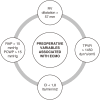Extracorporeal Mechanical Circulatory Support after Pulmonary Thromboendarterectomy: Experience of One Center
- PMID: 39111866
- PMCID: PMC11320365
- DOI: 10.5761/atcs.oa.24-00070
Extracorporeal Mechanical Circulatory Support after Pulmonary Thromboendarterectomy: Experience of One Center
Abstract
Purpose: Pulmonary thromboendarterectomy (PTE) is the treatment for patients with chronic thromboembolic disease. In the immediate postoperative period, some patients may still experience life-threatening complications such as reperfusion lung injury, airway bleeding, and persistent pulmonary hypertension with consequent right ventricular dysfunction. These issues may require support with extracorporeal membrane oxygenation (ECMO) as a bridge to recovery or lung transplantation. This study aims to analyze our series of PTEs that require ECMO.
Methods: A descriptive and retrospective analysis of all PTE performed at the Favaloro Foundation University Hospital was conducted between March 2013 and December 2023.
Results: A total of 42 patients underwent PTE with a median age of 47 years (interquartile range: 26-76). The incidence of patients with ECMO was 26.6%, of which 53.6% were veno-venous (VV) ECMO. Preoperatively, a low cardiac index (CI), high right and left filling pressures, and high total pulmonary vascular resistances (PVRs) were associated with ECMO with a statistically significant relationship. The hospital mortality was 11.9%, and the mortality in the ECMO group was 45.5%, with a statistically significant relationship. Veno-arterial ECMO has a worse prognosis than VV ECMO.
Conclusions: Preoperatively, a low CI, high right and left filling pressures, and high total PVRs were associated with ECMO after PTE.
Keywords: ECMO; chronic thromboembolic pulmonary hypertension; extracorporeal membrane oxygenation; pulmonary thromboendarterectomy.
Figures



References
-
- Mayer E, Jenkins D, Lindner J, et al. Surgical management and outcome of patients with chronic thromboembolic pulmonary hypertension: Results from an international prospective registry. J Thorac Cardiovasc Surg 2011; 141: 702–10. - PubMed
-
- Humbert M, Kovacs G, Hoeper MM, et al. 2022 ESC/ ERS Guidelines for the Diagnosis and Treatment of Pulmonary Hypertension Developed by the Task Force for the Diagnosis and Treatment of (ESC) and the European Respiratory Society (ERS). Eur Heart J 2022; 43: 3618–3731. - PubMed
-
- Thistlethwaite PA, Mo M, Madani MM, et al. Operative classification of thromboembolic disease determines outcome after pulmonary endarterectomy. J Thorac Cardiovasc Surg 2002; 124: 1203–11. - PubMed
-
- Jamieson SW, Kapelanski DP, Sakakibara N, et al. Pulmonary endarterectomy: experience and lessons learned in 1,500 cases. Ann Thorac Surg 2003; 76: 1457–64; discussion, 1462-4. - PubMed
-
- Freed DH, Thomson BM, Berman M, et al. Survival after pulmonary thromboendarterectomy: Effect of residual pulmonary hypertension. J Thorac Cardiovasc Surg 2011; 141: 383–7. - PubMed

